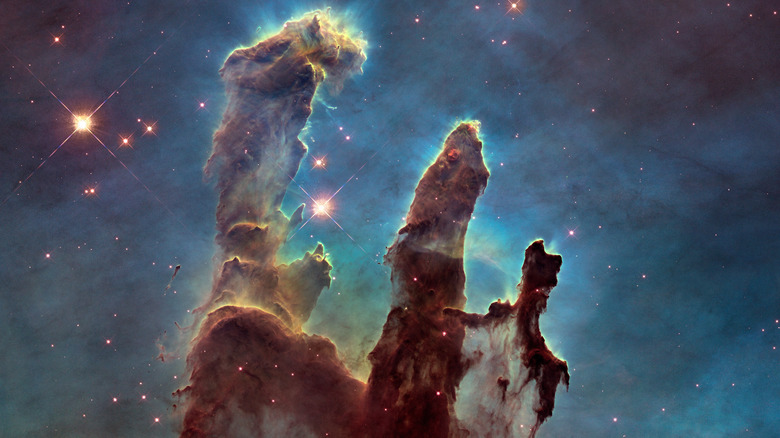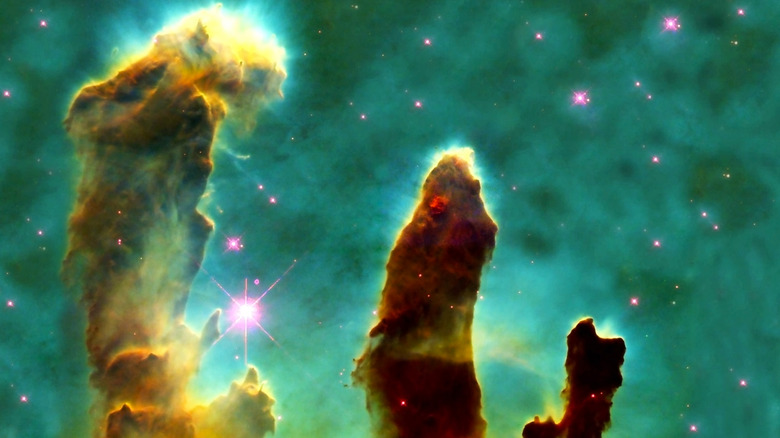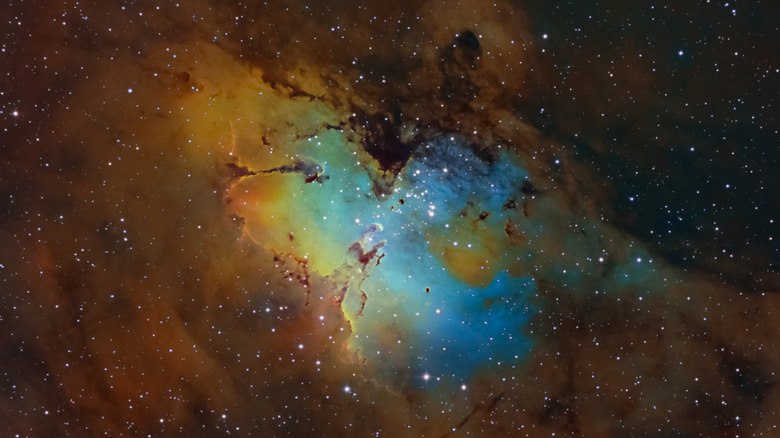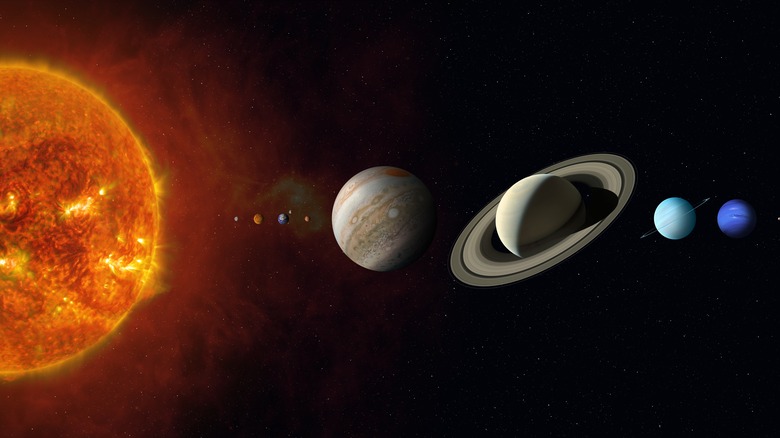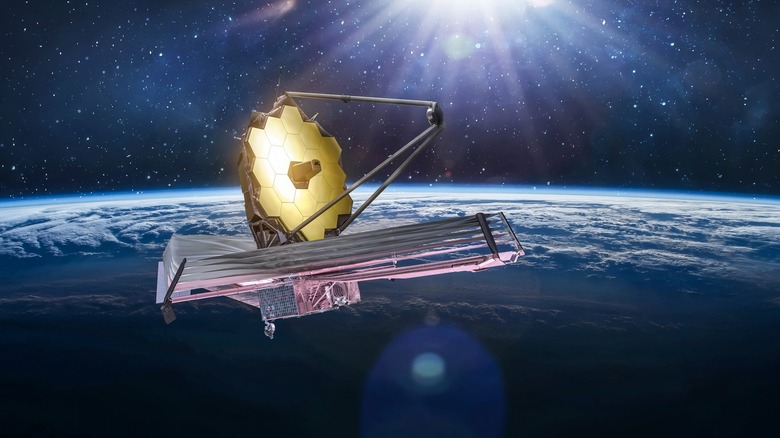What One Space Photo Tells Us About The Creation Of The Universe
Stargazers and curious minds have long been fascinated by what the universe has to offer, including the massive amounts of mystery. Looking up at the night sky, it's nearly impossible to fathom just how much, and how many stars, are actually all around us. What's even more intriguing is that the stars and planets we see in our sky are actually light years away. For most of history, we haven't been able to get a good look at what exactly goes on in the mysterious outer space above us, but astrophotographers have caught some mesmerizing images in the last few decades that have brought us a little closer to understanding the universe and all of its wonder.
Recently, the image resembling a galactic mountain range, which NASA is calling NGC 3324 (hidden within the Carina Nebula, according to the NASA website), was released to the public. The image is a part of a star-forming region and was made possible by NASA's new James Webb Space Telescope. The mountain range of vibrant colors and bright stars is incredible and not the first image of its kind. Another image first captured in 1995 gave those of us here on Earth a glimmer of understanding regarding our vast home. This image is equally impressive and even earned itself the title "The Pillars of Creation."
The Hubble Space Telescope had to capture the Pillars of Creation through multiple images
Jeff Hester and Paul Scowen, astronomers from Arizona State University, meticulously put together 32 separate images captured from multiple angles with the Hubble Space Telescope in 1995 using the Wide-Field Planetary Camera 2, according to an article published in Jekko. The final product was the awe-inspiring image known as "The Pillars of Creation." The photo shows what looks like three chaotic and distinct tendrils reaching up into the stars around them. The picture's powerful name originated from the phrase "pillars of creation" in a sermon delivered by a Christian minister, Charles Spurgeon, when he preached (via Alchetron), "And now wonder ye angels, the Infinite has become an infant; he, upon whose shoulders the universe hangs ... he who created all things and bears up the pillars of creation," according to an article published in Nature TTL.
In 2014, technological advancements and a new camera, the Wide-Field Camera 3, allowed for a more updated version of the Pillars. This new version showcased more details and previously unseen stars to be visible. This is because the more recent version of the Wide-Field Camera captured its image of the Pillars in infrared light and in visible light, according to Hubblesite. The infrared light penetrated the Pillars' environs and showed plenty of new features to these monstrous and daunting forms. Prior to these photographs, the Pillars were still massive enough to be visible from Earth, resting between the Serpens and Sagittarius constellations, per an article published in Jekko.
The Pillars of Creation is a place where stars are born
The Pillars of Creation are just as mighty as they look. According to an article published in Jekko, the whole entity is five light-years wide, and the pillar on the left side of the image alone is over four light-years long. To put it in perspective, this means that our solar system doesn't even take up one of the small pieces that appear jutting out from the top of a pillar, also known to astronomers as "elephant trunks."
The camera that caught the most recent image of the pillars could give astronomers a clear look at interstellar formations in the "elephant trunks" by capturing near-infrared light along with visible light. These images allowed what was going on inside the pillars to be realized; these trunks are made of hydrogen, gas, and dust and are bona-fide star factories, albeit in a rather destructive fashion. Inside each pillar, new stars are able to consume the gas, hydrogen, and dusty contents. This extreme star-creating journey happening within the pillars is not something that only occurs within the Pillars of Creation. According to Jekko, astronomers are aware that star birth takes place all over the universe; however, the Eagle Nebula, where the pillars are, is the closest star factory to Earth, at just 6,500 light-years away.
Eagle Nebula is Earth's neighbor, only 7,000 years away
While the Pillars of Creation are technically in Earth's neighborhood of the universe, they're still 6,500 light-years away. This means that the first captured images of this space mass are around 7,000 years old. So how can images taken in 1995 be 7,000 years old? According to Jekko, it's because the light from the Eagle Nebula takes approximately 7,000 years to reach Earth. This time difference means that the formation has probably gone through a large series of changes from 1995 to present day, but astronomers will have to wait another 1,000 years to find out for sure.
It's even possible that the pillars don't exist anymore. Above them, there are groups of stars causing a process called photo-erosion. Photo-erosion is what happens when the young stars causing this are emitting UV light that erodes the gas and dust inside the pillars. This process has undoubtedly altered the pillars, or even decimated them entirely. However, we'll have to wait quite a long time to get another look.
The Pillars of Creation give astronomers insight into the birth of the Sun
The destruction the photo-erosion causes to the pillars is also creating the perfect environment for new stars to be born. According to Jekko, the erosion creates enough pressure within the pillars for the star-birthing process to take place. Thanks to the more recent images caught on the Wide Field Camera 3, astronomers are able to see this more clearly and get a closer glimpse of what the creation of the universe may have looked like.
According to NASA, Earth's Sun is most likely to have originated in a similar, chaotic, star-forming fashion, as there's evidence of radioactive shrapnel from a supernova in our still-forming solar system. This means that our Sun would have been formed by massive stars emitting ionizing radiation much like the ones creating a perfect star brewing storm within the Eagle Nebula. This discovery and ability to compare our neck of the woods with that of the Eagle Nebula and the Pillars of Creation gives astronomers insight into the origins of our universe.
Astrophotography advancements are helping astronomers understand the universe
The image of the Pillars of Creation is just one of many astounding images we now have of outer space, and capturing them is no easy feat. Even the 1995 photo of the pillars was captured on the Hubble with the Wide Field and Planetary Camera 2, which was actually four separate cameras. Each camera took photos of different parts of the pillars, creating an incredible puzzle to be pieced together by astronomers.
As astrophotography continues to progress, and even though the images may be thousands of years in the past, a closer glimpse into the creation of the universe and the environment around us is enough to fuel generations of wonder and research. From the Pillars of Creation in the Eagle Nebula to the NGC 3324 formation in the Carina Nebula recently captured with the James Webb Space Telescope, each photograph is profound and takes us on a journey of exploration in our own very large backyard.
